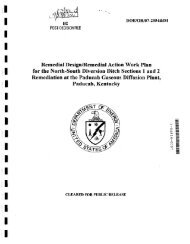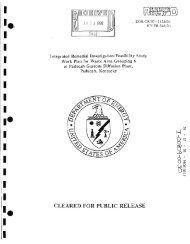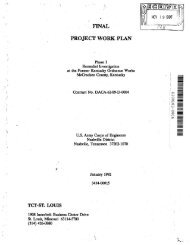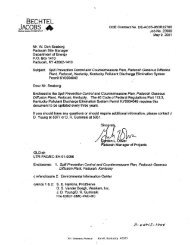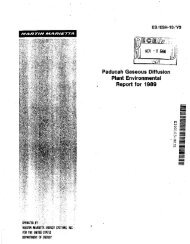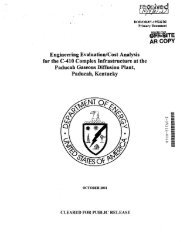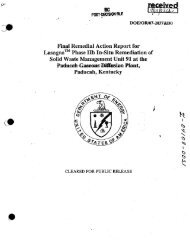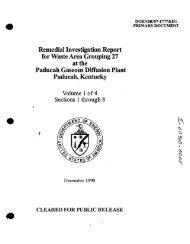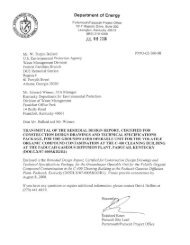1 - paducah environmental information center
1 - paducah environmental information center
1 - paducah environmental information center
You also want an ePaper? Increase the reach of your titles
YUMPU automatically turns print PDFs into web optimized ePapers that Google loves.
Paducah Site<br />
Programmatic Environmental Impact<br />
Statement for Alternative Strategies for<br />
the Long-Term Management and Use of<br />
Depleted Uranium Hexafluoride).<br />
On October 16, 1995, DOE submitted an<br />
Implementatipn Plan that incorporated complete<br />
and near-term actions in accordance with these<br />
five focus areas. The Implementation Plan also<br />
committed to managing the DUF 6<br />
Cylinder<br />
Program using a Systems Engineering Approach.<br />
The approach was developed concurrent with<br />
field response actions and is enhanced through<br />
an open dialogue between DNFSB staff and<br />
DOE and Energy Systems personnel. _ The<br />
Implementation Plan specifies the following<br />
interim and final deliverables and defines their<br />
respective cont~iit to establish an operative<br />
Systems Engineering process for the continued<br />
improvement of DUF 6<br />
management:<br />
• Contents Transfer; and<br />
• Off-site Transport.<br />
DOE is upgrading the quality of the<br />
cylinder yards to help maintain the integrity of<br />
the cylinders. Fewer cylinders are stored in the<br />
refurbished yards resulting in easier access for<br />
inspections to detect corrosion or leaks. To<br />
accommodate the resulting space needs, DOE<br />
initiated construction of a new 470,000 square<br />
feet cylinder yard (C-745-T) which was<br />
completed during the spring of 1998. The C-<br />
745-L (North) cylinder yard was reconstructed<br />
in 1999 and covers 196,000 square feet. The<br />
design for refurbishment of more existing<br />
storage yards is complete and the reconstruction<br />
is planned for FY 2000-2003, pending funding.<br />
o<br />
o<br />
o<br />
System Requirement Document -<br />
identifies the system requirements;<br />
System Engineering Management<br />
Plan - identifies organization, direction,<br />
and controls for system integration;<br />
Engineering Development Plan -<br />
. identifies development actions, costs,<br />
and schedules for technical<br />
improvements;<br />
• DUF 6<br />
Cylinder Program<br />
Management Plan - identifies costs,<br />
schedules, and controls for operating the<br />
system and implementing required<br />
actions; and<br />
• Approved Safety Analysis Reports<br />
defines the safety envelope.<br />
The system includes several operational<br />
functions to maintain containment of the DUF 6<br />
•<br />
These operational functions are:<br />
• Surveillance and Maintenance;<br />
• Handling and Stacking;<br />
In May 1997 the DOE communicated to the<br />
DNFSB that two cyl~nderpopulations needed to<br />
be painted to remain compliant with. National<br />
Board Inspection Code (NBIC) "in service"<br />
pressure vessel standards. At Paducah a<br />
population of approximately 3,870 cylinders<br />
(former G yard bottom-row cylinders) were<br />
identified as requiring to be painted by 2010.<br />
Because it was not logical to separate the<br />
cylinders on the bottom row from the top row, it<br />
was determined that a total of approximately<br />
7,800 cylinders at Paducah would be painted.<br />
During fiscal years 1996, 1997, and 1998 a total<br />
of 3,368 cylinders were painted. Cylinder<br />
painting activities at Paducah were terminated<br />
after 1998 in light of DOE's near term plans to<br />
begin conversion of the depleted UF6 in. 2005.<br />
If conversion begins in 2005 the remaining<br />
worst case cylinders can be converted by 2010.<br />
If conversion does not become operational in<br />
2005, alternative mitigating actions, such as<br />
restarting cylinder painting operations will need<br />
to be implemented.<br />
In December 1998 toxicity test results at<br />
KPDES Outfall 017 exceeded the KPDES limit<br />
for toxicity (see discussion in Section 2).<br />
Subsequent tests confirmed the toxicity<br />
exceedance and a Toxicity Reduction Evaluation<br />
Plan was established. Zinc from cylinder<br />
3-18<br />
Environmental Program Information



